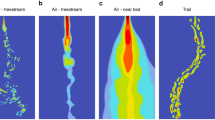Summary
In response female pheromone the male gypsy moth flies a zigzagging path upwind to locate the source of odor. He determines wind direction visually. To learn more about the mechanism underlying this behavior, we studied descending interneurons with dye-filled micro-electrodes. We studied the interneuronal responses to combinations of pheromone and visual stimuli.
-
1.
We recorded 5 neurons whose directionally selective visual responses to wide field pattern movement were amplified by pheromone (Figs. 2–6).
-
2.
The activity of the above neurons was more closely correlated with the position of the moving pattern than with its velocity (Fig. 4).
-
3.
One neuron showed no clearly directional visual response and no response to pheromone. Yet in the presence of pheromone it showed directionally selective visual responses (Fig. 6).
-
4.
We recorded 4 neurons whose directionally selective visual responses were not modulated by pheromone (Fig. 7), ruling out the possibility that the effect of the pheromone was simply to raise the activity of all visual neurons.
-
5.
Our results suggest that female pheromone amplifies some neural pathways mediating male optomotor responses, especially the directionally selective responses to the transverse movement of the image, both below and above the animal.
Similar content being viewed by others
Abbreviations
- CNS :
-
central nervous system
- VNC :
-
ventral nerve cord
References
Baker TC, Willis MA, Phelan PL (1984) Optomotor anemotaxis polarizes self-steered zigzagging in flying moths. Physiol Entomol 9:365–376
Christensen TA, Hildebrand JG (1987) Functions, organization and physiology of the olfactory pathways in the lepidopteran brain. In: Gupta AP (ed) Arthropod brain: Its evolution, development, structure, and functions. Wiley, New York, pp 457–4483
Hausen K, Egelhaaf M (1989) Neural mechanisms of visual course control in insects. In: Stavenga DG, Hardie RC (eds) Facets of vision. Springer, Berlin Heidelberg New York, pp 391–424
Kaissling KE, Thorson J (1980) Insect olfactory sensilla: Structural, chemical and electrical aspects of the functional organization. In: Satelle DB, Hall LM, Hildebrand JG (eds) Receptors for neurotransmitters, hormones and pheromones in insects. Elsevier/North Holland, Amsterdam, pp 261–282
Kennedy JS (1983) Zigzagging and casting as a programmed response to wind-borne odour: a review. Physiol Entomol 8:109–120
Kennedy JS, Marsh D (1974) Pheromone-regulated anemotaxis in flying moths. Science 184:999–1001
Kramer E (1975) Orientation of the male silkmoth to the sex attractant bombykol. In: Denton DA, Coghlan JD (eds), Olfaction and taste, vol. 5. Academic Press, New York, pp 329–335
Kuenen LPS, Baker TC (1983) A non-anemotactic mechanism used in pheromone source location by flying moths. Physiol Entomol 8:277–289
Olberg RM (1983) Pheromone-triggered flip-flopping interneurons in the ventral nerve cord of the silkworm moth, Bombyx mori. J Comp Physiol 152:297–307
Preiss R, Futschek L (1985) Flight stabilization by pheromone-enhanced optomotor responses. Naturwissenschaften 72:435–436
Preiss R, Kramer E (1983) Stabilization of altitude and speed in tethered flying gypsy moth males: influence of (+) and (−)- disparlure. Physiol Entomol 8:55–68
Preiss R, Kramer E (1986) Mechanism of pheromone orientation in flying moths. Naturwissenschaften 73:555–557
Willis MA, Baker TC (1987) Comparison of manoevres used by walking versus flying Grapholita molesta males during pheromone mediated upwind movement. J Insect Physiol 33:875–883
Willis MA, Cardé RT (1990) Pheromone-modulated optomotor response in male gypsy moths, Lymantria dispar L.: Upwind flight in a pheromone plume in different wind velocities. J Comp Physiol A 167:699–706
Author information
Authors and Affiliations
Rights and permissions
About this article
Cite this article
Olberg, R.M., Willis, M.A. Pheromone-modulated optomotor response in male gypsy moths, Lymantria dispar L.: Directionally selective visual interneurons in the ventral nerve cord. J Comp Physiol A 167, 707–714 (1990). https://doi.org/10.1007/BF00192665
Accepted:
Issue Date:
DOI: https://doi.org/10.1007/BF00192665




